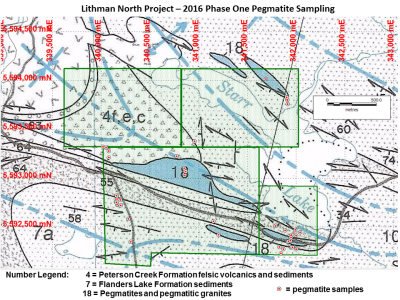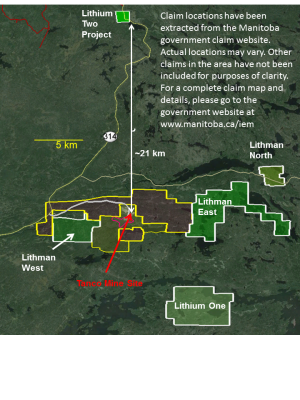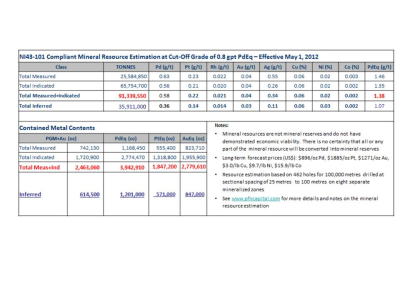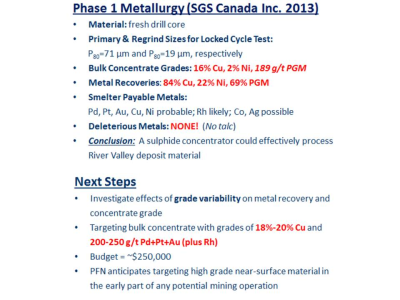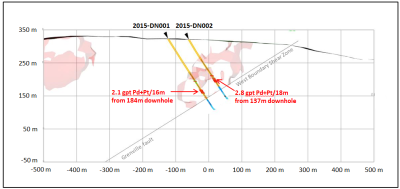- Phase One Program of Pegmatite sampling completed on Pacific North West Capital’s Lithium Projects in SE Manitoba, by its 100% owned Lithium Division, Lithium Canada Developments (LCD)
- Â Numerous Pegmatites were reviewed and sampled in the field
- Â Assay results revealed anomalous REE and Rare Metals, in several localities, on the Project area
- Â Recommendation is for a Detailed Field Mapping and Sampling Program for the Spring of 2017, followed by a Summer/Fall Drill Program.
November 14th, 2016 / Vancouver, British Columbia – Pacific North West Capital Corp. (“PFN” the “Company”) (TSXV: PFN; OTCQB: PAWEF; FSE: P7J) is pleased to announce that its 100% owned subsidiary, Lithium Canada Developments, has received and reviewed the Assays from its 2016 Phase One Field Program on the Lithman North Project. The Project is situated in SE Manitoba, approximately 150 kilometres NE of Winnipeg, Manitoba.
The Lithman North Project is located in the Cat Lake area of the Winnipeg River Pegmatite Field. This Pegmatite field hosts the world-class Tanco Pegmatite, which has been mined at the Tanco Mine Site, since 1969. The mine was a Spodumene (a Lithium mineral) concentrate producer from 1986 to 2009, and a Tantalum mineral concentrate producer until March 2013. The mine presently produces Pollucite from the Tanco Pegmatite, which is used to make Cesium Formate. The Tanco Mine is operated by the Tantalum Mining Corporation of Canada (a division of the Cabot Corporation) and was previously North America’s Largest and Sole Producer of Spodumene, Tantalum and Cesium. The Lithman North Project is located approximately 15 kilometres NE of the Tanco Mine Site. The Project is accessible via an all-weather road transecting the Project area
A total of 56 field samples (See Figure 1) were collected of Surface Exposed Pegmatites, as part of the Phase One Program to Assess the exploration potential of the Pegmatites in the Project area. The work was carried out by the Company’s Consultants, from Manitoba. Pegmatites have been noted on historic government maps (1981 ER80-1 Cerny, Trueman, Ziehike, Goad and Paul) but no indication of past exploration or evaluation of these Pegmatites was available. Field work confirms the existence of more numerous Pegmatites, than indicated in government mapping. A large portion of the project area has Pegmatites and Pegmatitic Granite exposed on the surface. The purpose of the Phase One sampling was to test the chemical and mineralogical nature of the Pegmatites.
Field work revealed evidence for several different Pegmatite Intrusive Events. Numerous Pegmatites were mapped as Albite Pegmatites with strong Mica contents. The Pegmatites ranged from simple to complex in mineralogical composition, and some displayed crude zoning. The area prospected was approximately 2 kilometres by 2 kilometres in size. Assay results for Field GrabSamples showed that several Pegmatite locations were enriched in Total Rare Earth Oxides plus Y (TREO + Y). Thirteen of the 56 samples contained more than 100 ppm TREO + Y. The maximum value was with up to 510 ppm TREO + Y ppm. In addition, assays for several grab samples from Surface Pegmatites returned elevated Rare Metal values of Gallium (up to 87 ppm), Niobium (up to 55 ppm), Tantalum (up to 65 ppm), and Rubidium (up to 494 ppm). Lithium Assays were low, which indicates that Spodumene minerals are not exposed at surface where sampled, but could be present at depth. This low-cost program of Prospecting and Sampling revealed that some of the Pegmatites have a complex minerology, that with more work, could prove to be interesting. Further exploration is recommended.
Figure 1: Lithman North 2016 Pegmatite Sample Sites on Government 1980 Geology Map
Surface Sampling of Pegmatites can be a challenging field exercise in the assessment of a Pegmatite, because some Pegmatites are zoned and surface exposure reflects erosion levels. From the field review and Assay results, the Company’s Consultants recommend a Program of Detailed Mapping and Sampling, to be carried out in the Spring of 2017, with a Drill Program to follow. These Pegmatites have never been Drill Tested.
Samples of the Pegmatites were sent to the Activation Laboratories facility in Ancaster, Ontario for Assay Analysis. Samples were prepared using the lab’s Code RX1 procedure, in which samples are crushed up to 95%, passing through a 10 mesh, riffle split and then pulverized with mild steel, to 95%, passing 105 um. Assay Analyses were completed using the lab’s Ultratrace 7 Package. This package includes a Sodium Peroxide Fusion (which allows for a total metal recovery and is effective for the analysis of Sulphides and refractory minerals) and ICP-OES and ICP-MS instrumentation finish. Due to the Reconnaissance and Prospecting nature of the Phase One Program, standards or and blanks were not submitted with the samples. It is recommended, for the Detailed Mapping/Sampling Program and for Drilling, that a QA/QC Program of Standards and Blanks be implemented.
To date, the Company is the Largest Mineral Claim Holder in the Cat Lake-Winnipeg River Pegmatite Field of SE Manitoba. The Company uses a Prospector Generator Model and is currently negotiating Option/Joint Ventures with interested parties, for the Company’s Lithium Projects.
Pacific North West Capital Corp. has two divisions; a Lithium Division and a PGM Division.
About PFN’s Lithium Division
The Company’s Lithium Division will focus on the Discovery, Acquisition, Exploration and Development of Lithium Projects in Canada. In the United States, the Company will use its wholly owned U.S.A subsidiary to Acquire and Develop Projects, in Active Mining Camps, in Nevada, Arizona and California.
Management believes that these New Age Metals; Lithium, PGMs and Rare Earths, have Robust Macro Trends, with Surging Demands and Limited Supply. Going forward, this New Division will Explore for the Minerals needed to fuel the demand for Energy Storage and other Core 21st Century Technologies.
The Company has a Growing Portfolio of Lithium Projects: The Clayton Valley Forks Li Project, in Nevada, is a recent Lithium Brine Project, Acquired by the Company (see PFN News Releases: April 25th, 2016 and May 9th, 2016). The Company also has several Hard Rock Lithium Projects in Canada: To date the Company has Acquired 5 Hard Rock Lithium Projects, in the Winnipeg River Pegmatite Field, in SE Manitoba(see PFN News Releases: April 21st, 2016;May24th, 2016; June 15th, 2016; July 5th, 2016 and July 21st, 2016). This Pegmatite Field hosts the Giant Tanco Pegmatite Mine that has been mined for Tantalum, Cesium and Spodumene (one of the Primary Lithium Ore Minerals) in varying capacities, since 1969. Today, the Tanco Mine is focused on the Mining and Production of Cesium Formate, a drilling fluid for the petroleum industry. PFN’s Li Projects are strategically situated to Further Explore this Pegmatite Field.Presently, the Company is the Largest Claim Holder in the Winnipeg River Pegmatite Field.
Lithium and Platinum Group Metal Prices have improved drastically, in recent months. Lithium supplies remain in deficit, relative to their demand. Both Metals Groups are used for the expanding worldwide automobile industry (conventional and electric). In the case of PGM’s, demand is increasing for Autocatalysts, a key component for reducing toxic emissions, for automotive, gasoline and diesel engines. Regarding Lithium, there is an ever-increasing demand for batteries in cellphones, laptops, electric cars, solar storage, wireless charging and renewable energy products.
Figure 2: PFN’s (Lithium Canada Dev.) Lithium Projects in Manitoba, Surrounding the Tanco Mine
Figure 3: Company Claim Blocks in the Clayton Valley area of Nevada
(Figure 3 is a Company-made Composite and not intended for redistribution.
The Company accepts no responsibility for the accuracy of these claim blocks, other than the claim block associated with the Clayton Valley Forks Li Project)
Clayton Valley is located in Esmeralda County, Nevada, host to the Albemarle Corporation’s Silver Peak Lithium Mine and Brine Processing Operations. The mine has been in operation since 1967 and remains the only Brine-Based Lithium Producer in North America. The New Project Acquisition, in Nevada, provides the Company a Project, in an area that is well known for its Lithium Carbonate Production. Clayton Valley is a Centralized Location in Nevada, with Highway Access, Power Infrastructure, Water and Local Labor.
The company’s new Lithium Brine Project will be approximately 3.5 hours away from Tesla’s Gigafactory, which has a planned annualLithium-ion battery production capacity of 35gigawatt-hours per year, by 2020. The CV West Li Project is located approximately 3 hours north of the Faraday Electric Car Factory, to be operated in Las Vegas, Nevada.
Clayton Valley is one of the few locations globally, known to contain Commercial-Grade Lithium-Enriched Brines.
About PFN’s Platinum Group Metals Division
River Valley is Canada’s Largest Undeveloped Primary PGM Deposit.
Achievements to date and Future Plans, for River Valley, are outlined below as follows:
- 1.PFN currently has 100% ownership in the River Valley Project, subject to a 3% NSR, with Options to Buy Down
- 2.Completed Exploration and Development Programs, on the River Valley Property:
Include more than 600 holes drilled, since year 2000, and several Mineral Resource Estimates and Metallurgical Studies
- 3.Results for the current (2012) Mineral Resource Estimate are below
- 4.2015 Drill Program confirms New High Grade T2 Discovery
- 5.Exploration and Development Plans outlined for 2016
- 6.Ongoing Strategic Partner Search for River Valley Project
- 7.Results for the current Mineral Resource Estimate are summarized below:
– Prepared by Tetra Tech (Wardrop)
– High Confidence: Measured plus Indicated = 72% of total
– Reported on PdEq basis: Pd=40% & Pt=20% of the Payable Metals
– Pd to Pt ratio = 2.5:1; Cu to Ni ratio = 3:1
– High Grade Potential: particularly in the north part of the River Valley Deposit
- 8.Results for the 2015 Discovery Drill Program on the T2 Target are as follows:
-
- -Drill hole intercepts much higher than the average grade, of current Mineral Resource Estimate-Possible New Mineralized Zone at the north end of the River Valley Deposit-Show potential to take the River Valley PGM Project in a New Direction-More drilling required and field crews have completed ground-proofing targets, to better plan Fall and Winter Drill Programs
- 9. Exploration and Development Plans for 2016:
-
- -Mineral Prospecting and Geological Mapping on surface: In Progress-Drill Programs targeted to add more, higher grade: Drilling Started October 2016-Geological Interpretation and 2D/3D Modelling of all Drill and Surface Results-Ongoing Strategic Partner Search for River Valley
Resources under Evaluation for Development Potential as Open Pit Mining Operation:
QUALIFIED PERSON
The contents contained herein, which relate to Exploration Results or Mineral Resources, are based on information compiled, reviewed or prepared by Dr. Bill Stone, Principal Consulting Geoscientist, for Pacific North West Capital. Dr. Stone is a Qualified Person, as defined by National Instrument 43-101 and has reviewed and approved the technical content.
On behalf of the Board of Directors
“Harry Barr”
Harry G. Barr
Chairman and CEO
Neither the TSX Venture Exchange nor its Regulation Services Provider (as that term is defined in the policies of the TSX Venture Exchange) accepts responsibility for the adequacy or accuracy of this release.
Cautionary Note Regarding Forward Looking Statements: This release contains forward-looking statements that involve risks and uncertainties. These statements may differ materially from actual future events or results and are based on current expectations or beliefs. For this purpose, statements of historical fact may be deemed to be forward-looking statements. In addition, forward-looking statements include statements in which the Company uses words such as “continue”, “efforts”, “expect”, “believe”, “anticipate”, “confident”, “intend”, “strategy”, “plan”, “will”, “estimate”, “project”, “goal”, “target”, “prospects”, “optimistic” or similar expressions. These statements by their nature involve risks and uncertainties, and actual results may differ materially depending on a variety of important factors, including, among others, the Company’s ability and continuation of efforts to timely and completely make available adequate current public information, additional or different regulatory and legal requirements and restrictions that may be imposed, and other factors as may be discussed in the documents filed by the Company on SEDAR (www.sedar.com), including the most recent reports that identify important risk factors that could cause actual results to differ from those contained in the forward-looking statements. The Company does not undertake any obligation to review or confirm analysts’ expectations or estimates or to release publicly any revisions to any forward-looking statements to reflect events or circumstances after the date hereof or to reflect the occurrence of unanticipated events. Investors should not place undue reliance on forward-looking statements.
Tags: #mining, #smallcapstocks, $TSXV, lithium

